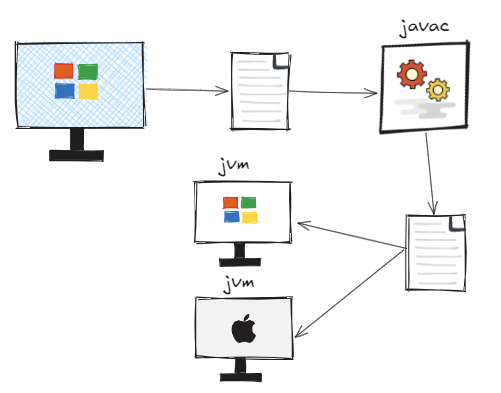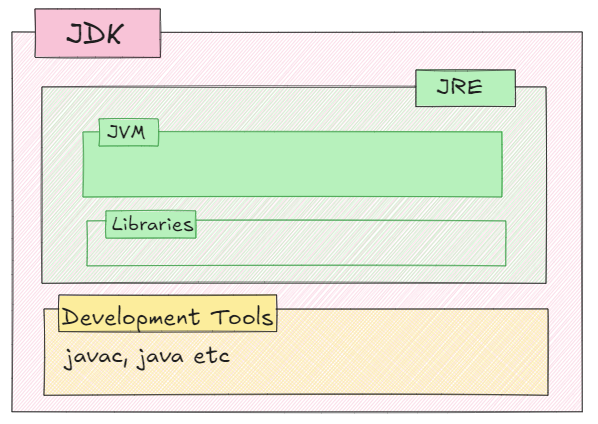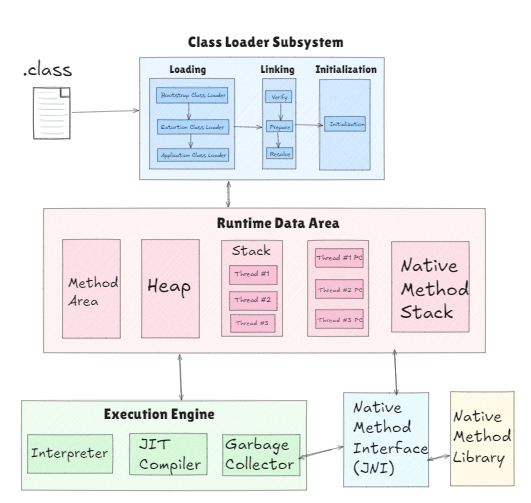The Java Platform Explained
Java is Platform Independent

Java works on the principle of WORA – Write Once, Run Anywhere. A Java program is compiled into bytecode, which can run on any system that has a Java Virtual Machine (JVM), regardless of the underlying operating system or hardware.
⚠️ Performance trade-off? Since bytecode is converted to machine code at runtime, execution can be slightly slower compared to natively compiled languages like C or C++.
Difference between JDK, JRE and JVM ?

JVM (Java Virtual Machine): The heart of the Java platform. It executes Java bytecode and provides platform independence.
JRE (Java Runtime Environment): Contains the JVM and standard Java libraries. It’s enough to run Java applications but not to develop them.
JDK (Java Development Kit): A full development kit including the JRE, plus tools like the Java compiler (javac), debugger, and other utilities needed to write and compile Java programs.
Inside the JVM - Architecture Breakdown
Its a virtual machine/abstract computer that simulates a real computer. It is used to execute java byte code file.

Key components of JVM
- Class Loader - Takes .class file and check for valid byte code
- Runtime Data Area - Has stack ( stores methods) and Heaps ( stores objects and is expandable unlike stack )
- Execution Engine - Responsible for execution of byte code.
💡Note - Each Java program is run by a single instance of the JVM, which is created when the program starts and terminated when it ends.
JVM implementations and languages
There are several implementations of the JVM available for different operating systems and architectures (32-bit and 64-bit). Examples - Amazon Corretto, Oracle HotSpot, and OpenJ9. JVM languages are programming languages that compile down to Java bytecode, allowing them to run on any JVM. For example, a Python program compiled to bytecode using Jython can be executed on the Java platform.
What are JAR files ?
JAR stands for Java Archive. It’s a file format used to bundle multiple Java class files, resources, and metadata into a single file. They can be executed directly(if have main class in manifest) or as a library. Think of JAR as a ZIP tailored for java.
Is java compiled or interpreted ?
Its hybrid. First compiled to byte code, then interpreted by JVM.
- Initial Phase: The interpreter allows the program to start and run quickly without waiting for compilation.
- Optimization Phase: The JIT compiler identifies “hot” methods (methods that are used frequently) and compiles them to native code for faster execution. ✅ The interpreter helps your code run quickly at first, and the JIT compiler steps in later to optimize frequently executed code.
Java flavours
- Java SE ( Standard Edition ) - Core libraries for general-purpose applications
- Java EE (Enterprise Edition, now called Jakarta EE**)-** For building large-scale, distributed enterprise apps, includes apis like Servlets, JSPs, JMS, JPA, JAX-RS, Java Authentication and Authorization service.
Note- It is different from Spring Framework in way that it is a specification with multiple vendors (WebSphere, GlassFish) while Spring is a open-source framework developed by VMware. - Java ME ( Micro Edition ) - Designed for embedded systems, mobile devices(feature phones) and IOT devices.
- Java FX - For building rich desktop GUI applications.